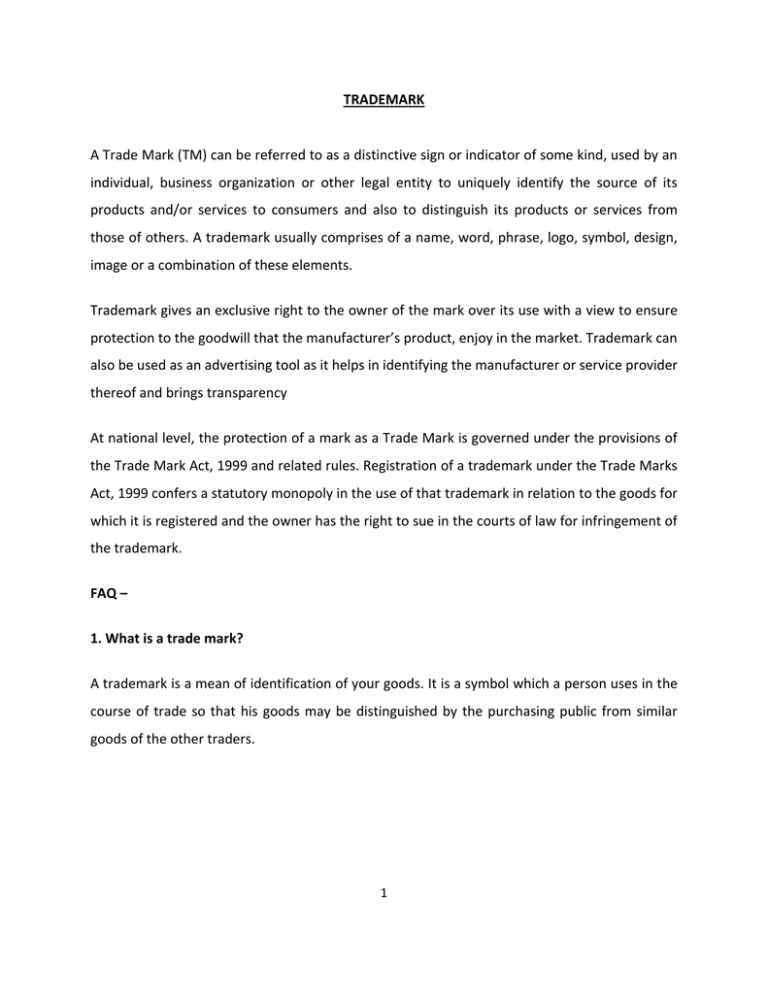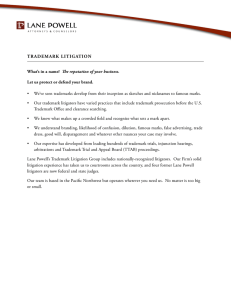TRADEMARK A Trade Mark (TM) can be referred to as a distinctive
advertisement

TRADEMARK A Trade Mark (TM) can be referred to as a distinctive sign or indicator of some kind, used by an individual, business organization or other legal entity to uniquely identify the source of its products and/or services to consumers and also to distinguish its products or services from those of others. A trademark usually comprises of a name, word, phrase, logo, symbol, design, image or a combination of these elements. Trademark gives an exclusive right to the owner of the mark over its use with a view to ensure protection to the goodwill that the manufacturer’s product, enjoy in the market. Trademark can also be used as an advertising tool as it helps in identifying the manufacturer or service provider thereof and brings transparency At national level, the protection of a mark as a Trade Mark is governed under the provisions of the Trade Mark Act, 1999 and related rules. Registration of a trademark under the Trade Marks Act, 1999 confers a statutory monopoly in the use of that trademark in relation to the goods for which it is registered and the owner has the right to sue in the courts of law for infringement of the trademark. FAQ – 1. What is a trade mark? A trademark is a mean of identification of your goods. It is a symbol which a person uses in the course of trade so that his goods may be distinguished by the purchasing public from similar goods of the other traders. 1 2. How a trade mark shall be selected? Proper selection of the trademark is necessary for business as well as legal point of view. From the general business point of view, the trademark shall be easy to pronounce, remember, attractive and as far as possible short. From the legal point of view, the trademark shouldn’t fall under section 9 of the Act which mentions all absolute grounds for refusal, i.e. it should not be a personal name, surname, geographical name, name of a tribe / caste or refer to the character or quality of the goods. A good trademark should be an inherently distinctive trademark, preferably an invented or COINED WORD. 3. Is registration of trade mark compulsory under Indian Laws? The registration of a trade mark in India, is not mandatory but desirable to avail the benefits conferred by the law. A registered trademark confers a bundle of exclusive rights upon the registered owner, including the right to exclusive use of the mark in relation to the products or services for which it is registered. 4. Can a similar trade mark be used / registered? As per judicial dicta, there should be only one trade mark, one source & one proprietor. Thus, it is neither permissible nor advisable to do so. It has been so allowed in the circumstances, only where the mark has been adopted honestly and bonafidely used for sufficiently long period of time. 5. Adoption of a mark registered / used for one set of goods / services, for another set of goods / services by different persons? Yes, the same is permissible to be used in respect of different goods and/or services. 2 6. How to find out whether a trade mark is available or not? It is advisable for every business entrepreneur, to go for official trade mark search of the proposed mark from the office of the registrar of trademarks, before filing its registration application and/ or start using it in respect of your goods / services. The authentic search can only be obtained from the office of the Registrar of trade marks. In case of confusion / existence of similar mark, counter opinion from a Trade Mark lawyer is a must. 7. Honest Concurrent User? If it is found that there is a resembling mark on the register (or any other previous application is pending w.r.t. any similar mark, the trademark may still be registered on proof of the honest and bonafide adoption of the trade mark and sufficiently long and continuous user of your trademark subject to the satisfaction of the Registrar of the Trade Marks. The period of honest and concurrent user is not defined in the act however in number of cases, the use of Trade Mark for a period of 5-6 years or more has been allowed for such qualification. 8. Criteria of Registrar and Courts for deciding similarity / deceptively similarity? The foremost criteria for determining confusing or deceptive similarity is whether an unwary purchaser i.e. a common prudent person will be confused or not, which are further determined by the OCCULAR as well as PHONETIC similarity of the mark, the getup, color combination, design and artwork of the label, packing material etc.. 9. Legal remedies on infringement and / or passing off of a trade mark? Both Civil and Criminal remedies are available under the provisions of The Trade Marks Act, 1999. Please note, when there is an invasion of the statutory rights of a person i.e. a Registered Trade Mark Holder, it is called an infringement of trade mark. (Section 29) In all other cases, in 3 respect of unregistered trade marks, the legal actions are called “Passing Off” actions. (Section 27) In a civil action, following remedies are available: Interim Injunction Permanent Injunction Accounts & Damages The court has the power to not only pass interim injunctions but also the power to order for the delivery of the infringing material bearing the trademark of the plaintiff. Besides this, the court may also issue directions to give true and faithful account of the illegal profit so earned and the damages suffered by the owner of the trademark. 10. Cancellation of a registered trade mark? Yes, in certain circumstances even a registration of a trade mark can be cancelled, such as where the registration has been obtained by Playing fraud upon the Registrar, as to information and circumstances or when a registered trade mark is not used for a continuous period. 11. Authority for registration of trade mark internationally? There is no such international authority .The trade mark is a state subject, and one has to apply for registration in each and every country separately. Some more elaboration on various aspects relating to Trademark – Registration: Under the Indian laws, the proprietary rights in relation to a Trade Mark may be established through actual use in the marketplace or through registration of the mark with the trademarks office / registry of a particular jurisdiction. The Trade Marks Rules, 2002 under Rule 25 to 62 govern the procedural aspects relating to the registration of Trade Mark which can be done on any of the registration office at four metropolitan cities Delhi, Mumbai, Kolkata & Chennai. The mark to be registered must be distinctive and must not be descriptive. 4 Disadvantages for non-registration: No person shall be entitled to institute any proceeding to prevent, or to recover damages for, the infringement of an unregistered trade mark. Assignment & Transmission: The trademark is assignable as well as transmissible which can be done after following procedural formalities in connection with Assignment & Transmission. Registered User: A person can use the trademark as a registered user subjects to certain conditions. Rectification and Correction of Register of Trademark: After following the procedure there can be made correction in register of trademark or amendment in classification of goods. Special Provision for Certification Trademark: The Act provides special procedure for registration of certification trademark. Infringement and Passing off: A registered proprietor of a trademark can prevent others from using an identical or deceptively similar trademark in relation to any goods in respect of which the mark is registered by either civil suit or criminal complaint for passing off. Check List of Information & Documents required for Trade Mark registration in India – a. Name of Trade Marks to be registered for search; b. LOGO / Trade Mark to be registered; c. Name, address, legal entity and Nationality of the applicant; d. Detail of Product or Service; e. Trade Description: Manufacturing / Trading / Service; f. Little information about the product; g. Name and designation of the person authorized to sign the application and other documents; h. Duly executed Power of Attorney; i. If the proposed trade mark id already in use, date from which being used 5

